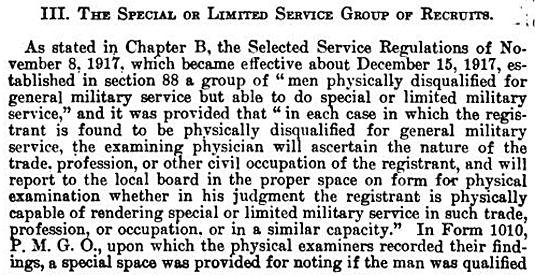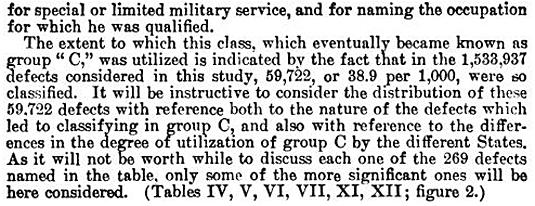![]() 1st Battalion 22nd Infantry
1st Battalion 22nd Infantry ![]()
The Syracuse Recruit Camp 1918
Overview
With the entry of the United
States into World War I nation-wide conscription was instituted
under the Selective Service Act of May 18,1917. Under this act
some 2.8 million men were eventually
drafted into military service. Four physical qualification groups
were constituted by the Selective Service
System. Group "A" consisted of men physically fit for
full military service. Group "B" was men with physical
defects which could be remedied. Group "C" was men with
certain defects which could prevent them from full
military service yet still serve in some capacity. Group
"D" were those rejected completely for any military
service.
The necessity of quickly raising
a large Army led to the utilization of men who might otherwise be
exempted or deferred
because of physical or other defects. Though such defects could
prevent their use as front line soldiers they could still
be employed in rear and support areas performing jobs and
positions important to the overall function of the military.
Therefore a special class of inductees was comprised of such men
and was termed
"The Special or Limited Service Group of Recruits."

 *
*
As can be seen in the above
passage there were some 269 conditions which caused an inductee
to be included in Group "C",
the class of recruits known as the "Special or Limited
Service Group." Examples of those conditions were: curvature
of the
spine, arthritis, mental deficiency, defective vision or hearing,
heart disorders, flat feet, underweight, obesity, asthma and
blindness in one eye. Extreme cases could be cause for rejection
altogether but those who possessed any of the defects
listed in the category of Group "C" and deemed unfit
for front line service could still be assigned to rear echelon
duty.
In 1917 a Mobilization Camp was
established on the outskirts of Syracuse, New York to process
inductees into the Army.
Elements of the 9th Infantry, 16th Infantry and the 5th Machine
Gun Battalion were stationed there to operate the camp.
On July 19, 1918 the camp was renamed The Syracuse Recruit Camp and taken over by the 22nd Infantry.
The Syracuse Recruit Camp was
established to process a segment of the draftees who were
classified as members of the
Special and Limited Service Group. It was estimated that once
operational the Camp would handle a total of approximately
26,000 recruits. The permanent military organization at the Camp
consisted of Companies G, K and M of the 22nd Infantry,
the Machine Gun Company and the Supply Company of the 22nd
Infantry, a detachment of the Quartermaster Corps, and
a detachment of the Medical Department.
Major (Temporary) Samuel G.
Talbot, newly assigned to the 22nd Infantry in June, 1918 was the
Commanding Officer of the
Camp at its opening on July 19, 1918 and held command until
August 19 when he left for other duties, having received a
further
promotion to the temporary rank of Lieutenant Colonel. He was
replaced by Lieutenant Colonel (Temporary) Brady G. Ruttencutter
who remained in command of the Camp until its closure.
Ruttencutter had been with the 22nd Infantry for a year, had
commanded
Company G, and held the permanent rank in the Regular Army of
Major, his temporary promotion to Lieutenant Colonel occurring
on August 5, 1917, the same date he was assigned to the 22nd
Infantry. Ruttencutter would be the Commander of the Camp
during the flu epidemic of 1918. Ruttencutter's second in command
at the Camp was his adjutant Captain Sidney F. Mashbir
who had been commissioned a 2nd Lieutenant in the 22nd Infantry
on March 21, 1917. On October 2, 1918 Mashbir was
promoted to the temporary rank of Major.
During the years 1918-1920 a
world-wide pandemic of influenza devastated the globe, killing
more people than were killed
during the four years of World War I. With large scale movements
of personnel and material across the shipping lanes of
the world's oceans, the influenza virus rapidly spread across the
planet with alarming speed.
In the United States the disease
first appeared in Kansas among the civilian population
and at Fort Riley, and quickly spread to other military camps
during the period of January to March 1918.
In August, 1918 a second wave of
the pandemic struck the United States, first arriving in Boston,
Massachusetts and
swiftly moving throughout military camps across the country. This
second wave was caused by a mutated form of the
influenza virus which was especially infectious and particularly
deadly among those of military age. Because of the war
military medical resources in the United States were limited and
as soldiers and recruits were moved to civilian hospitals
and medical care facilities the flu spread further into the
already infected civilian population as well.
At the outbreak of the epidemic
in the Syracuse Recruit Camp on September 12, 1918 the total
number of personnel
under Ruttencutter's command at the Camp was 14,114 of which
11,604 were recruits of the Special and Limited
Service Group qualification.
|
Brady Green Ruttencutter Photo taken in Syracuse, New York 1918. Ruttencutter had served in
combat in the Philippines with After commanding Company G of
the 22nd Infantry Photo by George W. Fenner from the Onondaga County Public Library |
|
Sidney Forrester Mashbir Photo taken in Syracuse, New York 1918. Mashbir had served along the
Mexican Border with the He was commissioned a 2nd
Lieutenant in the 22nd Infantry Photo by George W. Fenner from the Onondaga County Public Library |
At the Recruit Camp there were
five infirmaries with a total of forty-five beds set up to handle
sick call and to give temporary care
to those deemed too sick for duty. On August 3, 1918 the first
case of influenza was reported at the Camp. Between September 4
and September 10 approximately 10,000 new recruits reported to
the Camp. Between August 3, when the first case of influenza
occurred, and September 12 a total of seven cases of influenza
were diagnosed. However, after the influx of new recruits in
September
cases of the disease began to climb rapidly. Most of the recruits
reporting to the Camp in September came from Massachusetts,
the area from which the second wave of the nationwide pandemic of
influenza started, and the majority of those who were infected
during the epidemic at the Camp were from that group of recruits
or otherwise came in contact with that group.
A large number of men made ill
by the epidemic were transferred to hospitals and medical care
facilities in the nearby city of
Syracuse. Some were sent to the military hospital at Fort Ontario
some thirty-five miles away. Eventually some mess halls at the
Recruit Camp were converted into hospital wards and an exhibit
building at the New York State Fair Grounds nearby was
also converted into a makeshift hospital.
Eventually 2289 cases of
influenza would occur at the Syracuse Recruit Camp during the
22nd Infantry's tenure there
and of those 208 would result in death. The official dates of the
epidemic at the Camp were from September 12 through October 15,
1918.
Once the epidemic at the Camp
was deemed to have ended in mid-October it was decided to close
the Camp. Though this website
could not find the actual date of its closing, that date appears
to be sometime in November 1918 after a period of quarantine to
be
sure no new cases of influenza occurred.
The 22nd Infantry left the
Syracuse Recruit Camp in three increments. Company G was
transferred to Anatol, New Jersey, October 19.
Companies K and M were transferred from the Syracuse Recruit Camp
to Fort Jay, N. Y., November 18-19, 1918;
the Supply and Machine Gun Companies went from Syracuse to Fort
Hamilton, N. Y., the following day.
*
Defects Found in Drafted Men: Statistical Information Compiled
from the Draft Records Showing the Physical Condition
of the Men Registered and Examined in Pursuance of the
Requirements of the Selective-Service Act
by Albert Gallatin Love, United States Surgeon-General's Office,
U.S. Government Printing Office, 1920 pp. 197-198
Home | Photos | Battles & History | Current |
Rosters & Reports | Medal of Honor | Killed
in Action |
Personnel Locator | Commanders | Station
List | Campaigns |
Honors | Insignia & Memorabilia | 4-42
Artillery | Taps |
What's New | Editorial | Links |